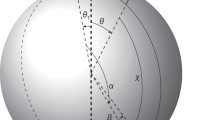Abstract
It is shown that if neutron stars contain dynamically de-coupled components, most plausibly discrete superfluid zones, then it is possible for the spin axes of these components o become slightly misaligned with respect to the crustal spin following a series of glitches. The crust will then undergo Lense-Thirring precession about the total angular moment with a period of ∼ 6–7.5P (assuming a crustal superfluid) and ∼ 3–6P (if the core superfluid is not tightly coupled to the crust). The precise precessional period is diagnostic of the mass distribution within each component. The implications of recent observational inferences concerning glitching pulsars are discussed. The conditions necessary for precession to be observable are analysed phenomenologically and a search of pulse-timing data for evidence of a Lense-Thirring modulation within the period range ∼ 3–8P is proposed.
Similar content being viewed by others
References
Alpar, M. A., Chau, H. F., Cheng, K. S., Pines, D. 1993,Astrophys, J.,409, 345
Alpar, M. A., Pines, D., Cheng, K. S. 1990,Nature,348, 707
Baym, G. 1993,Isolated Pulsars, ed. K. A. Van Riper, R. Epstein & C. Ho, Cambridge: Cambridge University Press p. 1
Baym, G., Pethick, C., Pines, D., Ruderman, M. 1969,Nature,224, 872
Bildsten, L., Epstein, R. I. 1989,Astrophys. J.,342, 951
Cordes, J. M., Downes, G. S., Krause-Polstorff, J. 1988,Astrophys. J.,330, 847
Chau, H. F., McCulloch, P. M., Nandkumar, R., Pines, D. 1993,Astrophys. J.,413 L113
Epstein, R., Baym, G., Link, B. 1993,Isolated Pulsars, ed. K. A. Riper, R. Epstein & C. Ho Cambridge: Cambridge University Press p. 10
Feynman, R. P. 1972,Statistical Mechanics, New York:Benjamin
Flanagan, C. S. 1990,Nature,345, 416
Hamilton, A. J. S., Sarazin, C. L. 1982,Monthly Notices Roy. Astron. Soc.,198, 59
Hide, R. 1978,Rotating Flows in Geophysics, ed. P. H. Roberts and A. M. Soward London: Academic Press p. 3
Jones, P. B. 1991,Astrophys. J.,373, 208
Lyne, A. G. 1987,Nature,326, 569
Lyne, A. G., Graham-Smith, F., Pritchard, R. S. 1992,Nature,359, 706
McCulloch, P. M., Hamilton, P. A., McConnell, D., King, E. A. 1990,Nature,346, 822
Michel, F. C., Bland-Hawthorn, J., Lyne, A. G. 1990,Monthly Notices Roy. Astron. Soc.,246, 624
Pethick, C. J., Ravenhall, D. G. 1992,Phil Trans. R. Soc. A.,341, 17
Pines, D., Shaham, J., Ruderman, M. 1972,Nature Phys. Sci.,237, 83
Radhakrishnan, V., Manchester, R. N. 1969,Nature,222, 228
Reichley, P. E., Downs, P. S. 1969,Nature,222, 229
Reisenegger, A. 1993,JLow Temp Phys,92, 77
Ruderman, M. 1993,Isolated Pulsars, ed. K. A. Van Riper, R. Epstein & C. Ho Cambridge: Cambridge University Press p. 66
Sauls, J. A. 1989,Timing Neutron Stars, ed. H. Ogelman & E. P. J. van den Heuvel Dordrecht: Kluwer p. 457
Thorne, K. S., Price, R. M., MacDonald, D. 1986,Black Holes-The Membrane Paradigm, New Haven: Yale University Press
Author information
Authors and Affiliations
Rights and permissions
About this article
Cite this article
Blandford, R.D. Lense-thirring precession of radio pulsars. J Astrophys Astron 16, 191–206 (1995). https://doi.org/10.1007/BF02714834
Issue Date:
DOI: https://doi.org/10.1007/BF02714834




